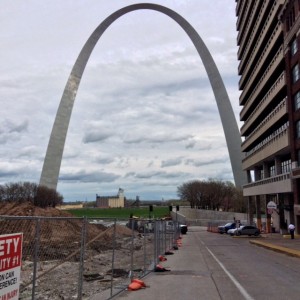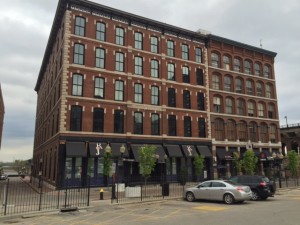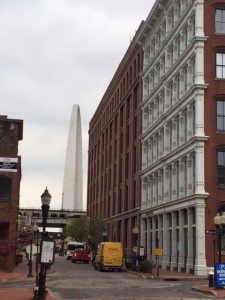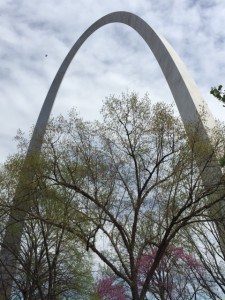It’s been four years since I launched Barbara A. Campagna/Architecture + Planning, PLLC and while many things have changed, my goal to work on “greening what’s already here” continues to be met, often in places I never expected. Many people are finding new ways to integrate historic preservation and green building practices, which makes my new venture a delightful and intellectually inspiring one. This is blog five of my anniversary week.
Isn’t MCM So Dang Cool?
Last week I attended a truly fabulous symposium in St. Louis – Mid Century Modern Structures Symposium sponsored by NCPTT and the World Monuments Fund. Franklin Mares, Deputy Superintendent of the Jefferson National Expansion Memorial set the tone for the week by welcoming us all and proclaiming, “Isn’t MCM so dang cool?” And yes, we all think it is, which is one of the reasons I suspect many of us find ourselves working on it.
Walter Sedovic, a New York-based preservation architect at Walter Sedovic Architects, discussed the “Mad Men” phenomenon, which has certainly revived an interest in the late 50s and 60s. He reminded us that however amazing and cool we might find the Arch, it was the site of a former cast iron district, some of which remains adjacent to the Arch in the Leclede’s Landing neighborhood. But that is one of the great ironies of the modern era. Many modern buildings, neighborhoods and even icons replaced earlier buildings and neighborhoods that we would consider historic today. But that is all part of the evolution of our cultural and architectural history.
“The Architecture of Today”
Presentations on new modern materials and new building types rounded out the symposium. Caroline Guay, a conservator at Conservation Solutions explained how Googie architecture reflected the optimism of the time and helped launch space movement design. Evan Kopelson of Vertical Access and Nancy Hudson of Robert Silman Assocations shared their examination of the Tent of Tomorrow at Philip Johnson’s 1964 NY World’s Fair Pavilion, identifying damaged cables and steel structure corrosion on these structures, which were intended to be temporary, but are still standing 51 years later. Conservator Mary Jablonski shared the work her students in the Columbia Conservation Workshop conducted on objects made from Fiber Reinforced Plastics (FRP) at the 1964 World’s Fair. It was a wonder material that was intended to be “A better way to a more carefree life.” They conserved an original plastic (polyester resin) bench for the Queen’s Museum. Some of the original aluminum frames of the benches have had their FRP slats removed and replaced with wood, which was not a good alteration and people have discovered that the FRP is infinitely more comfortable than the wood.
Modernism at Risk
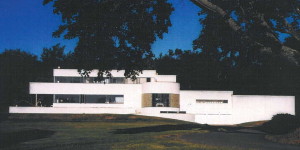
Richard H. Mandel House. The first International Style house designed by Edward Durell Stone, a few years before the A. Conger Goodyear House which is a WMF Modernism at Risk project. (I prepared the National Register nomination for this groundbreaking building, built in 1935.)
David E. Bright from Knoll discussed the Modernism at Risk program they have been working on with the World Monuments Fund. This signature advocacy effort brings modern buildings forward. As per their website, WMF’s concern for modern sites began in the 1980s, but the establishment of WMF’s Modernism at Risk Initiative, launched in 2006 with founding sponsor Knoll, allows WMF to take a more active role in addressing the distinct threats facing great works of modern architecture around the world. This program focuses on advocacy, conservation, and public education and has highlighted buildings by Rudolph, Breuer, Edward Durell Stone (A. Conger Goodyear House) and other luminaries across the world.
Carol Dyson, Chief Architect at the Illinois Historic Preservation Agency, suggested that in considering MCM commercial modernism, maybe storefront evolution is okay and should be honored. Holly Hope, from the Arkansas SHPO, discussed the features of ranch houses built from 1945-1970, which make them significant and discussed the National Register listing of Ranch House neighborhoods around the country, from Arkansas to Georgia, North Carolina to Oregon.
I was sorry to see this symposium end. I have not been this re-energized by a conference in quite some time. Perhaps it was the combination of new thinking and fun building types, which helped warm us up after such a long, harsh winter, or even the examination of the buildings from our childhood. I find something actually quite joyful in Mid Century Modern architecture and even find it in Brutalism. The new forms, the new materials, the new building types, the hope in a new world – it offers endless possibilities for an architect with a preservation and sustainability focus.
And if you’d like to “subscribe” or follow my blog, True Green Cities, please sign up through the “Subscribe” button at the bottom left of this page. You’ll receive a daily recap when new blogs are posted. Or Sign up for the Feed, also at the bottom left of this page.

